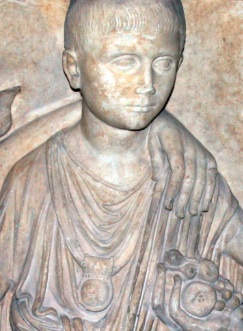Bulla (amulet)
Bulla (amulet) is an ancient Roman amulet worn by children. Traditionally, a bulla was given to a child at birth and was believed to protect them from evil spirits and harm. This piece of jewelry holds significant historical and cultural value, illustrating aspects of ancient Roman life, beliefs, and practices regarding protection and childhood.
History and Usage[edit | edit source]
The tradition of wearing a bulla began around the 6th century BC and continued throughout the Roman Empire until the 4th century AD. It was typically made of gold, leather, or cloth, depending on the family's social status. The bulla of a freeborn child was made of gold, while those of lesser status were made of leather or cloth. It contained amuletic items such as phallic symbols, believed to ward off the evil eye, or other materials thought to have protective properties.
A bulla was worn around the neck by Roman children, both boys and girls, from the time of their birth until they reached maturity. For boys, this was marked by the ceremony of the Toga virilis, where they would put on the toga of manhood, usually around the age of 16, and for girls, it was their marriage. Upon reaching these milestones, the bulla was traditionally dedicated to the household gods, the Lares, as a rite of passage.
Design and Contents[edit | edit source]
The design of a bulla could vary but often was a pouch, locket, or a container that could be opened to place protective items inside. These items were chosen for their supposed magical properties that could protect the wearer from harm. The contents of a bulla might include charms, amulets, or other objects considered to have the power to avert evil influences or harm.
Cultural Significance[edit | edit source]
The bulla is a significant artifact in the study of ancient Roman culture, providing insight into Roman beliefs about magic, protection, and the transition from childhood to adulthood. It reflects the importance placed on safeguarding the young, who were considered particularly vulnerable to supernatural and worldly threats. The practice of wearing a bulla also highlights the societal emphasis on rites of passage and the delineation between the stages of life in ancient Rome.
Modern Interpretations[edit | edit source]
Today, replicas of bullae are sometimes created for educational purposes or by enthusiasts of ancient Roman culture. They serve as a tangible connection to the past, allowing modern individuals to gain a deeper understanding of Roman life and beliefs. Additionally, the concept of the bulla has influenced contemporary jewelry designs, with modern amulets and lockets drawing inspiration from this ancient tradition.
Search WikiMD
Ad.Tired of being Overweight? Try W8MD's physician weight loss program.
Semaglutide (Ozempic / Wegovy and Tirzepatide (Mounjaro / Zepbound) available.
Advertise on WikiMD
|
WikiMD's Wellness Encyclopedia |
| Let Food Be Thy Medicine Medicine Thy Food - Hippocrates |
Translate this page: - East Asian
中文,
日本,
한국어,
South Asian
हिन्दी,
தமிழ்,
తెలుగు,
Urdu,
ಕನ್ನಡ,
Southeast Asian
Indonesian,
Vietnamese,
Thai,
မြန်မာဘာသာ,
বাংলা
European
español,
Deutsch,
français,
Greek,
português do Brasil,
polski,
română,
русский,
Nederlands,
norsk,
svenska,
suomi,
Italian
Middle Eastern & African
عربى,
Turkish,
Persian,
Hebrew,
Afrikaans,
isiZulu,
Kiswahili,
Other
Bulgarian,
Hungarian,
Czech,
Swedish,
മലയാളം,
मराठी,
ਪੰਜਾਬੀ,
ગુજરાતી,
Portuguese,
Ukrainian
Medical Disclaimer: WikiMD is not a substitute for professional medical advice. The information on WikiMD is provided as an information resource only, may be incorrect, outdated or misleading, and is not to be used or relied on for any diagnostic or treatment purposes. Please consult your health care provider before making any healthcare decisions or for guidance about a specific medical condition. WikiMD expressly disclaims responsibility, and shall have no liability, for any damages, loss, injury, or liability whatsoever suffered as a result of your reliance on the information contained in this site. By visiting this site you agree to the foregoing terms and conditions, which may from time to time be changed or supplemented by WikiMD. If you do not agree to the foregoing terms and conditions, you should not enter or use this site. See full disclaimer.
Credits:Most images are courtesy of Wikimedia commons, and templates Wikipedia, licensed under CC BY SA or similar.
Contributors: Prab R. Tumpati, MD

